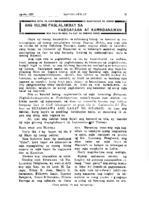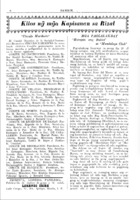The opening of Philippine ports to international trade in the 19th century (Manila in 1834 and the provinces in 1855) brought with it the enrichment of some families who, in the 1870s, began to send their descendants to complete their studies in Europe. Thus began the generation of the Enlightened and propaganda and also the beginning of a genre that had its peak in the first half of the 19th century: the travel story.
An instalment of Luna y Novicio's serialized account of his travels in Spain
As a genre, the travel story has been considered a hybrid because it is based on the real experiences of the authors. This has also meant that it has sometimes been studied from the point of view of history rather than literature. However, literary greats from all over the world have written travel books–John Steinbeck, Mark Twain, Juan Goytisolo, and Enrique Gómez Carrillo, to name a few. The purpose of travel books can be diverse: from satirical criticism to the search for administrative or social models to imitate in the Philippines, to simple literary enjoyment. They all, nonetheless, offer the gift of transporting the reader to other places.
Precisely the newspaper that the Filipino Ilustrados published in Spain, La Solidaridad, was home to an interesting serialized account of travels written by Antonio Luna y Novicio (the famous Heneral Luna) under the pseudonym Taga-Ilog.
In addition to being a travel book describing impressions of his stay in Spain, Luna’s text it is an ironic response to travel accounts with a clearly racist slant by some Spaniards who had passed through the Philippines, such as Pablo Feced "Quioquiap". Luna was not the only one to respond to Feced's provocative writings in the press: Graciano Lopez Jaena published in El liberal de Madrid a harsh response to the article “Ellos y nosotros”, in which Feced spoke of Filipinos as inferior humans.
Manuel Montes on Paris
Between 1902 and 1942, the Philippines was reflecting on what its independent future should look like. At that moment, travelogues often served as a source of ideas for nation-building. Thus many of them, such as Paz Mendoza Guazon's Notas de viaje from her voyage around the world, or Manuel B. Montes' article "Impresiones de un viaje rápido" (Impressions of a quick trip), emphasized what was admirable about other nations that could be adopted in the Philippines. On the other hand, other articles focused on the detestable that should be avoided, as is the case in this trip through communist Russia.
In addition to taking positive or negative examples, the travel book served to create ties with other nations, locate the Philippines in the world, and contrast imaginations of faraway places with reality. Sometimes travelers were not so much dedicated to taking examples from other nations, but to making the Philippines known to other nations, as the Ilustrados did in Spain. It is the case of Albert van Gasenwinkel, S.V.D., who, upon his return to Europe from Manila, he kept on talking about the country where he has lived for 25 years to the whole world.
Jesús Balmori, for his part, published a very special travel book in the pages of Excelsior newspaper. The curious thing is that on the trip, Balmori did not extend himself speaking to foreigners about the Philippines, but about Japan. Balmori traveled in 1931 to Mexico on a poetic mission: he intended to make Spanish-Filipino literature known in Latin America. His trip did not turn out to be as fascinating as he had anticipated. According to the chronicle of his passage through Japan on his way to Mexico, Japan was no longer the rural and mystical country he had read about and was being "corrupted" by the West. He chronicled his stay in Mexico in verse, in an original but critical way: the poetry he found there was not the poetry he had admired 30 years earlier. Mexico was vulgar to him, yet he found many similarities with the Philippines
Indeed, finding similarities with the homeland is a frequent passion of travelers, who often long for their homeland and speak of departure with nostalgia.
However, the trips were not always to faraway and exotic places: part of the Philippine nation-building mission was to highlight the country's modernity and showcase its economic strength. This was achieved by narrating short trips to provincial areas, such as on a excursion to Marikina in 1909, where we see admiration for the American way of life as an exponent of modernity as it was perceived in the 1930s.
Bibliographic references
Gasquet, Axel. 2020. "The Filipino poet Jesús Balmori: testimonial writings of his journey to Mexico (1932-1934)”, in Jie Lu et Martín Camps (eds.),Transpacific Literary and Cultural Connections. Historical and Cultural Interconnections between Latin America and Asia. Palgrave Macmillan: 45-66.
Park, Paula C. 2022. Intercolonial Intimacies Relinking Latin/o America to the Philippines, 1898-1964. Pittsburgh, Pa: University of Pittsburgh Press.
Villaescusa, Irene. 2018. "Un paseo por la modernidad: reflexiones de Paz Mendoza en sus Notas de viaje (1929)", Revista de Crítica Literaria Latinoamericana, 44, num. 88: 267-90.



